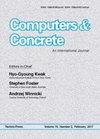RC deep beams with unconventional geometries: Experimental and numerical analyses
IF 3.3
4区 工程技术
Q2 COMPUTER SCIENCE, INTERDISCIPLINARY APPLICATIONS
引用次数: 0
Abstract
This work presents numerical and experimental analyses of the behavior of reinforced-concrete deep beams with unconventional geometries. The main goal here is to experimentally and numerically study these geometries to find possible new behaviors due to the material nonlinearity of reinforced concrete with complex geometries. Usually, unconventional geometries result from innovative designs; in general, studies of reinforced concrete structures are performed only on conventional members such as beams, columns, and labs. To achieve the goal, four reinforced-concrete deep beams with geometries not addressed in the literature were tested. The models were numerically analyzed with the Adaptive Micro Truss Model (AMTM), which is the proposed method, to address new geometries. This work also studied the main parameters of the constitutive model of concrete based on a statistical analysis of the finite element (FE) results. To estimate the ultimate loads, FE simulations were performed using the Monte Carlo method. Based on the obtained ultimate loads, a probabilistic distribution was created, and the final ultimate loads were computed.具有非常规几何形状的RC深梁:实验和数值分析
这项工作提出了具有非常规几何形状的钢筋混凝土深梁的行为的数值和实验分析。本文的主要目的是对这些几何形状进行实验和数值研究,以发现具有复杂几何形状的钢筋混凝土由于材料非线性而可能产生的新行为。通常,非常规的几何形状源于创新的设计;一般来说,钢筋混凝土结构的研究只在梁、柱和实验室等传统构件上进行。为了实现这一目标,我们测试了四个几何形状未在文献中提及的钢筋混凝土深梁。采用提出的自适应微桁架模型(AMTM)对模型进行了数值分析,以解决新的几何形状问题。在有限元结果统计分析的基础上,研究了混凝土本构模型的主要参数。为了估计极限载荷,采用蒙特卡罗方法进行了有限元模拟。根据得到的极限荷载,建立了概率分布,并计算了最终极限荷载。
本文章由计算机程序翻译,如有差异,请以英文原文为准。
求助全文
约1分钟内获得全文
求助全文
来源期刊

Computers and Concrete
工程技术-材料科学:表征与测试
CiteScore
8.60
自引率
7.30%
发文量
0
审稿时长
13.5 months
期刊介绍:
Computers and Concrete is An International Journal that focuses on the computer applications in be considered suitable for publication in the journal.
The journal covers the topics related to computational mechanics of concrete and modeling of concrete structures including
plasticity
fracture mechanics
creep
thermo-mechanics
dynamic effects
reliability and safety concepts
automated design procedures
stochastic mechanics
performance under extreme conditions.
 求助内容:
求助内容: 应助结果提醒方式:
应助结果提醒方式:


